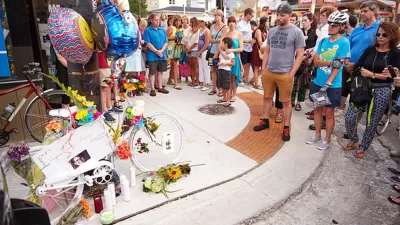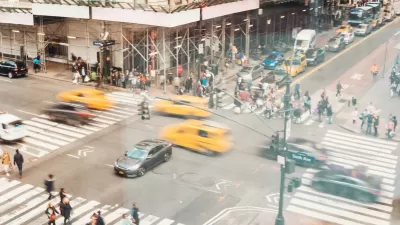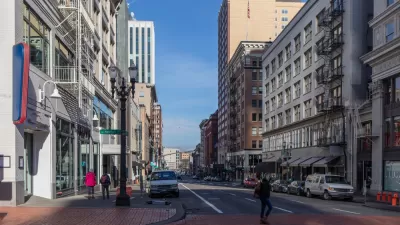To end traffic fatalities while still enabling urban mobility, cars will have to slow down and people will have to travel by other modes.

Antonio Loro writes an opinion piece on the subject of traffic safety and the inevitable backlash against efforts to achieve "Vision Zero" safety improvements.
It seems that some members of the public are more concerned that Vision Zero projects (like reducing vehicles lanes, adding traffic calming elements to the street, and improving bike infrastructure) will kill something more sacred than human life—the ability to quickly move from point a to point b in a car. Loro cites recent controversies over road diets on the Westside of Los Angeles as evidence of the willingness of some communities to sacrifice lives for the sake of mobility.
Loro's argument is just the opposite: that urban mobility must not sacrifice human lives. "To end road deaths, cities will have to tame unruly traffic, though it won’t be necessary to slow everything to a crawl; beyond that, more people will have to shift to modes of transport that, conveniently, are both safer than cars and provide more efficient ways to get around cities."
Loro details the kinds of measure that can slow down traffic, while pointing to the example of airline safety as an example of the kind of safety considerations that can be implemented for travel. Still, despite the many options for reconfiguring the street available to Vision Zero campaigns, people will still have to decide to travel by more efficient modes, like biking, walking, or riding public transit, if they want to improve traffic safety and improve congestion in the city.
FULL STORY: What’s the right number of people to kill on the roads? (Hint: it’s zero)

Alabama: Trump Terminates Settlements for Black Communities Harmed By Raw Sewage
Trump deemed the landmark civil rights agreement “illegal DEI and environmental justice policy.”

Planetizen Federal Action Tracker
A weekly monitor of how Trump’s orders and actions are impacting planners and planning in America.

Why Should We Subsidize Public Transportation?
Many public transit agencies face financial stress due to rising costs, declining fare revenue, and declining subsidies. Transit advocates must provide a strong business case for increasing public transit funding.

Understanding Road Diets
An explainer from Momentum highlights the advantages of reducing vehicle lanes in favor of more bike, transit, and pedestrian infrastructure.

New California Law Regulates Warehouse Pollution
A new law tightens building and emissions regulations for large distribution warehouses to mitigate air pollution and traffic in surrounding communities.

Phoenix Announces Opening Date for Light Rail Extension
The South Central extension will connect South Phoenix to downtown and other major hubs starting on June 7.
Urban Design for Planners 1: Software Tools
This six-course series explores essential urban design concepts using open source software and equips planners with the tools they need to participate fully in the urban design process.
Planning for Universal Design
Learn the tools for implementing Universal Design in planning regulations.
Caltrans
Smith Gee Studio
Institute for Housing and Urban Development Studies (IHS)
City of Grandview
Harvard GSD Executive Education
Toledo-Lucas County Plan Commissions
Salt Lake City
NYU Wagner Graduate School of Public Service





























